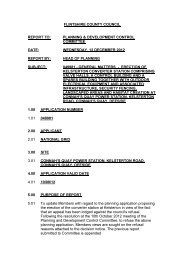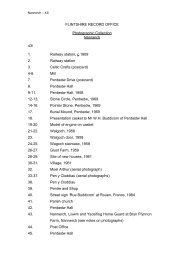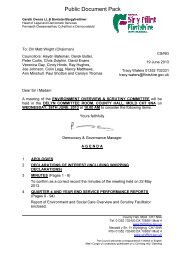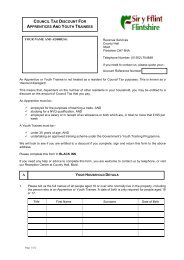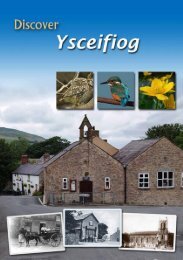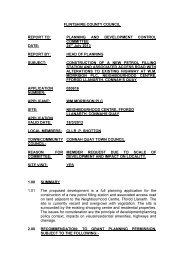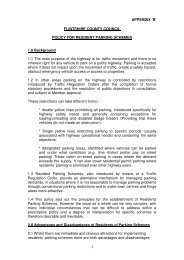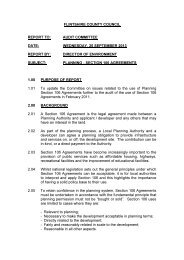15GreenfieldValleyA Medieval abbey, 19th century millsand a Victorian farmDistance: 4 km / 2.5 milesTime: 1 – 1.5 hrsPark<strong>in</strong>g and start: Greenfield Valley car park (SJ194774)on the B5121Grade: Easy, little climb<strong>in</strong>g, good surfacesTen M<strong>in</strong>ute Walk: Good surfaces with opportunity togo further if desiredFacilities: Greenfield toilets, tea rooms and museumopen April to October. <strong>Walks</strong> open all yearLivestock: NoneFurther <strong>in</strong>fo: Trail leaflet and <strong>in</strong>formation at VisitorCentre or shop (01352 714172)NB: Less rural than other walksAbaty o'r Oesoedd Canol, mel<strong>in</strong>au o'r19eg ganrif a fferm o oes FictoriaPellter: 4 km / 2.5 milltirAmser: 1 – 1.5 awrParcio a man cychwyn: Maes parcio Dyffryn Maesglas(SJ194774) ar y ffordd B5121Graddfa: Hawdd, ychydig o ddr<strong>in</strong>go, wyneb daTaith gerdded 10 munud: Llwybrau da a chyfle i fyndymhellachCyfleusterau: Caffi, canolfan gwybodaeth a siop, toiledauDa byw: DimRhagor o wybodaeth: Toiledau, caffi ac amgueddfa aragor rhwng mis Ebrill a mis Hydref. Llwybrau cerdded aragor drwy’r flwyddynD.S.: Llai gwledig na'r teithiau cerdded eraill50www.borderlands.co.ukAttractions for everyone <strong>in</strong> Fl<strong>in</strong>tshireLower Cotton MillMel<strong>in</strong> Gotwm IsafThe Walk1. From B5121 car park follow path signedAbbey Farm Museum.The car park was the site of a copper works wheresheets of copper were rolled to make cladd<strong>in</strong>g forships to protect their wooden hulls from parasiteattack. The pool that powered its wheel is allthat rema<strong>in</strong>s.At path junction, with Farm Museum ahead,turn R pass<strong>in</strong>g old school and EnvironmentCentre. Bear L uphill along lane.On the R is the pit for the waterwheel that poweredthe mach<strong>in</strong>ery for Abbey Mill that produced copperand brass wire for mak<strong>in</strong>g nails and p<strong>in</strong>s.2. Follow lane then take next R down steps andcross bridge to the Lower Cotton Mill site.The large rectangular ru<strong>in</strong> is all that rema<strong>in</strong>s ofthe six storey cotton mill built here <strong>in</strong> just 10weeks <strong>in</strong> 1785. The Cotton Twist Companyemployed up to 300 apprentices, many of themunder 10 years old. The cotton mill closed <strong>in</strong> 1840but it reopened as a corn mill <strong>in</strong> 1850, produc<strong>in</strong>gflour until the early 1900's.Cont<strong>in</strong>ue around RHS of old mill then turn Lbefore iron gates to cont<strong>in</strong>ue around back ofthe mill. Cross mill stream and go up steps. TurnR to rejo<strong>in</strong> lane. Where lane bears L by Flour MillPool reservoir, branch R keep<strong>in</strong>g alongsidereservoir. At sculpted metal gates, bear R tomore ru<strong>in</strong>s. Near reservoir overflow aboveMeadow Mill ru<strong>in</strong>s, bear L up steps. Partwayup turn R onto metal walkway across reservoir.Then turn L up steps to car park.Meadow Mill was built <strong>in</strong> 1787 to manufacturecopper rollers for pr<strong>in</strong>t<strong>in</strong>g patterns onto cloth.Three enormous waterwheels, 20 feet <strong>in</strong> diameter,provided the power for the copper roll<strong>in</strong>gmach<strong>in</strong>ery. The build<strong>in</strong>gs you see today date fromthe 1800s when there was a rubber gr<strong>in</strong>d<strong>in</strong>g worksand t<strong>in</strong> plate works on site.3. Cross car park head<strong>in</strong>g towards entrance,but turn L through metal KG before road. Passrema<strong>in</strong>s of clock tower on R then, after 10m,go R at path fork, past rema<strong>in</strong>s of the Batteryworks. Cont<strong>in</strong>ue around RHS of Battery Pool.Where path forks aga<strong>in</strong> go L across top of poolto come out <strong>in</strong> Royal Oak car park.The Battery Works have a poignant history.Established <strong>in</strong> 1776, they employed local people toshape pots and pans. The products were made by'batter<strong>in</strong>g' sheets of copper and brass with largehammers. The goods were exported from Liverpoolto Africa and used to buy slaves who were thentaken to America to work <strong>in</strong> the cotton fields.The cotton was then brought back for process<strong>in</strong>g,ensur<strong>in</strong>g that the ships always had a full cargo.
DyffrynMaesglas4. From car park turn L up steps. Then turn R onlower path pass<strong>in</strong>g chimney. Go thro' KG andbear R towards road, pass<strong>in</strong>g a warehouse.5. Turn L along road to visit St W<strong>in</strong>efride'sWell,100m further on. Retrace your stepsback thro' KG. Then take RH path to jo<strong>in</strong>disused railway track.Built <strong>in</strong> 1869, the railway was orig<strong>in</strong>ally usedto transport m<strong>in</strong>erals from local quarries toGreenfield Wharf. In 1913 it changed topassenger use and has carried many thousandsof pilgrims to St W<strong>in</strong>efride's Well.6. Stay on this track, ignor<strong>in</strong>g turn<strong>in</strong>gs on Land keep<strong>in</strong>g straight ahead at two major pathcross<strong>in</strong>gs. Eventually cross bridge and thendescend steps and turn L towards Bas<strong>in</strong>gwerkAbbey. Return to car park through park.Y Daith Gerdded1. O'r maes parcio dilynwch y llwybr sydd agarwydd Amgueddfa Fferm yr Abaty.Safle gwaith copr oedd y maes parcio. Ymaroedd haen o gopr yn cael ei rolio i wneudgorchudd i longau gan amddiffyn cragen bren yllong rhag parasitiaid. Y cyfan sydd ar ôl yw'rllyn o ddŵr oedd yn cynhyrchu'r ynni ar gyfer yrolwyn ddŵr.Ar gyffordd y llwybr, gyda'r Amgueddfa Ffermyn syth o'ch blaen, trowch i'r Dde gan fyndheibio'r hen ysgol a Chanolfan yr Amgylchedd.Cerddwch drwy'r giatiau a gwyro i'r Ch ifyny'r bryn ar hyd y lôn.Ar y LlDd mae pwll ar gyfer yr olwyn ddŵr oeddyn creu'r ynni i beiriannau Mel<strong>in</strong> yr Abaty oeddyn cynhyrchu gwifren gopr a phres i wneudhoelion a ph<strong>in</strong>nau.2. Dilynwch y lôn ac yna cymerwch y nesaf ary Dde i lawr y grisiau a chroesi'r bont i safle'rFel<strong>in</strong> Gotwm Isaf.Yr adfail mawr hirsgwar yw'r cyfan sydd ar ôl o'rfel<strong>in</strong> gotwm chwe llawr a godwyd yma mewn 10wythnos yn unig yn 1785. Roedd The CottonTwist Company yn cyflogi hyd at 300 oLead m<strong>in</strong>e trucksWagenni'r gwaith plwmbrentisiaid, nifer ohonyn nhw o dan ddegmlwydd oed. Caeodd y Fel<strong>in</strong> Gotwm yn 1840ond ail-agorodd yn fel<strong>in</strong> ŷd yn 1850, gangynhyrchu blawd hyd ddechrau'r 1900au.3. Ewch ymlaen o gwmpas LlDd yr hen fel<strong>in</strong>yna trowch i'r Ch cyn y giatiau haearncerfiedig a dal ymlaen o gwmpas cefn y fel<strong>in</strong>.Croesi nant y fel<strong>in</strong> a dr<strong>in</strong>go'r grisiau. Troi i'rDde i ailymuno â'r lôn. Ble mae'r lôn yn gwyroi'r Ch ger cronfa ddŵr pwll y Fel<strong>in</strong> Flawd,fforchio i'r Dde gan gadw wrth ochr y gronfaddŵr. Wrth y giatiau metal, gwyro i'r Dde atragor o adfeilion. Yn ymyl gorlifiant y gronfa ytu uchaf i adfeilion Mel<strong>in</strong> y Ddôl, gwyro i'r Chi fyny'r grisiau. Rhan o'r ffordd i fyny, troi i'rDde i lwybr metal dros y gronfa. Yna troi i'rCh i fyny'r grisiau ac i'r maes parcio.Codwyd Mel<strong>in</strong> y Ddôl yn 1787 i wneud rholeri coprar gyfer argraffu patrymau ar frethyn. Roedd tairolwyn ddŵr anferth, 20 troedfedd ar draws, yncynhyrchu pŵer i'r peiriannau rholio copr. Mae'radeiladau a welwch heddiw o'r 1800au pan oeddgwaith malu rwber a gwaith alcam ar y safle.4. Croeswch y maes parcio gan anelu am yfynedfa, ond trowch i'r Ch drwy GM fetel cyny ffordd. Ewch heibio olion tŵr cloc ar y Ddeyna, ar ôl 10m, ewch i'r Dde ar fforch y llwybr,heibio olion y Gweithfeydd Batri. Ewch ymlaeno amgylch LlDd'r Llyn Batri. Ble mae'r llwybryn fforchio unwaith eto, ewch i'r Ch ar drawspen y llyn a dod i faes parcio'r Royal Oak.Mae hanes <strong>in</strong>gol i'r Gweithfeydd Batri.Sefydlwyd yn 1776. Roedd yn cyflogi pobl leol isiapio llestri a phadelli. Gwnaed y cynnyrch drwyddyrnu ('Batter') haenau o gopr a phres âmorthwylion mawr. Allforiwyd y cynnyrch oLerpwl i Affrica ac fe'i defnyddiwyd i brynucaethweision a gyrchwyd i America i weithio yny meysydd cotwm. Yna cyrchwyd y cotwm yn ôli'w brosesu gan sicrhau bod y llongau bob amseryn llawn.5. O'r maes parcio, troi i'r Ch i fyny'r grisiau.Troi i'r Dde ar y llwybr isaf gan fynd heibiosimnai. Drwy'r GM a gwyro i'r Dde tua'r fforddgan fynd heibio warws. Troi i'r Ch ar hyd yffordd i weld Ffynnon y Santes Gwenfrewi.Ymhen 100m dychwelyd yr un ffordd a thrwy'rGM. Yna ar hyd y llwybr LlDd gan ymuno â henle<strong>in</strong> trên.Adeiladwyd y rheilffordd yn 1869, a chafodd eidefnyddio yn wreiddiol i gludo defnyddiau o'rchwareli lleol i Lanfa Maesglas. Yn 1913 dechreuoddteithwyr ei defnyddio a bu'n cyrchu miloedd oberer<strong>in</strong>ion i Ffynnon Wenfrewi.6. Arhoswch ar y trac hwn, anwybyddu'rtroeon i'r Ch a chadw'n syth ymlaen ar yddwy groesffordd fawr. Croesi'r bont ac ilawr y grisiau a throi i'r Ch tuag AbatyD<strong>in</strong>as Bas<strong>in</strong>g. Dychwelyd i'r maes parciodrwy'r Parc Treftadaeth.Bas<strong>in</strong>gwerk Abbey dates from 1132. The monkswere Cistercian, known as 'white monks' due to theirwhite habits. They used the power of the stream togr<strong>in</strong>d corn and also m<strong>in</strong>ed lead and silver, mak<strong>in</strong>gthe Abbey rich and powerful. Henry VIII's DissolutionAct forced the monks to leave the Abbey.St W<strong>in</strong>efride’s WellAccord<strong>in</strong>g to legend, <strong>in</strong> 660 AD Pr<strong>in</strong>ce Caradocdecapitated the beautiful W<strong>in</strong>efride becauseshe rejected his seduction. Her uncle, St Beuno,reunited her head and body. Water gushed fromthe ground where her head had fallen and this spotbecame the Holy Well. The well is believed to haveheal<strong>in</strong>g powers and became an important place ofChristian pilgrimage.Adeiladwyd Abaty D<strong>in</strong>as Bas<strong>in</strong>g yn 1132. Sistersiaidoedd y mynachod, galwyd hwy'n 'Frodyr Gwyn'oherwydd lliw eu habidau. Defnyddient rym y nanti falu ŷd ac arferent gloddio am blwm ac arian, ganwneud yr Abaty'n gyfoethog ac yn rymus. Ar ôlDeddf Diddymiad y Mynachlogydd, Harri'r VIII,gyrrwyd y mynachod o'r Abaty.Ffynnon GwenfrewiYn ôl y chwedl, yn 660 O.C. fe dorrodd y TywysogCaradog ben Gwenfrewi am iddi ei wrthod. UnoddSant Beuno, ei hewythr, ei phen a'i chorff. Llifodddŵr o'r ddaear ble syrthiodd ei phen a daeth y manyn ffynnon sanctaidd y credir bod iddi rym iachau.Daeth yn fan perer<strong>in</strong>dota Cristnogol.St W<strong>in</strong>efride’s WellFfynnon Gwenfrewiwww.borderlands.co.ukAtyniadau i bawb yn Sir y Ffl<strong>in</strong>t51



